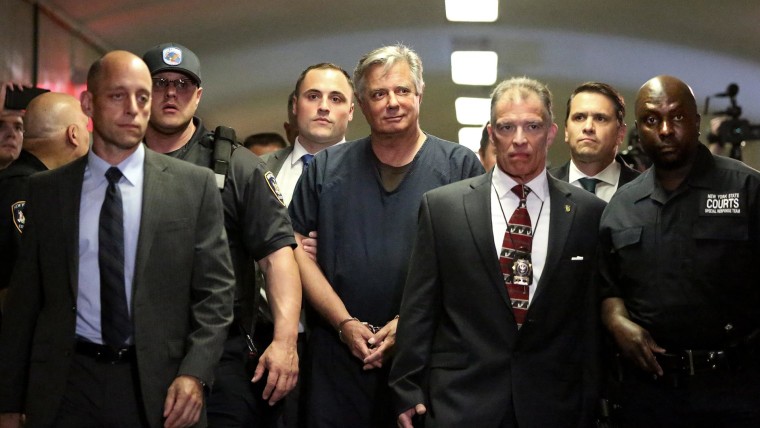‘Like a war zone’: Prison that freed Paul Manafort early now ravaged by Covid
Rodney Wyatt has lived more than a few lives in his 52 years.
There was his life in the drug trade more than a decade ago that landed him a 22-year sentence for conspiracy to distribute cocaine, and his life as a loving father and fiancé. There’s his life as a patient, in which he has suffered two heart attacks and endured 42 rounds of radiation treatments for prostate cancer.
And there’s his life now, as one of more than 620 prisoners at FCI Loretto in Pennsylvania who contracted Covid-19 in the last month in what was, by mid-December, the worst outbreak in the federal prison system.
“He said it’s just like a war zone,” said Chantel Tyler, 43, Wyatt’s fiancé. “They’re coughing on each other. Guys are vomiting on each other because they’re so close.”
Wyatt hoped that his illnesses would qualify him for compassionate release, but like most federal prisoners who applied, Wyatt was denied. The Bureau of Prisons also has not granted him home confinement, as it did for Paul Manafort, President Donald Trump’s former campaign chairman.
The Bureau released Manafort, 71, to home confinement in May, after Manafort’s lawyers argued he was at higher risk due to heart disease and past illness. Wyatt remains locked down in a prison where coronavirus has spread like wildfire.
As a brutal second wave of the coronavirus pandemic sweeps across the country, a second wave is also pummeling the federal Bureau of Prisons. Within the last month, about 12,000 prisoners have tested positive for Covid-19, bringing the total number of federal prisoners who have contracted the disease during the pandemic to more than 32,000. More than 2,500 staff have also been infected.
The outbreak is reigniting questions over why certain inmates – but not others – are granted early release or home confinement, and about the BOP’s measures to stem the spread inside.
Despite time to plan in recent months, and a scathing inspector general report that found deadly mistakes at a Louisiana facility this summer, Loretto was caught flatfooted, according to prisoners, their families and advocates.
Men were tested too slowly and not separated quickly enough, prisoners and advocates said. Those with symptoms were put in pods meant for those without the virus. The prisoners in the segregation unit have gone weeks without basic supplies, like sufficient soap, according to interviews and a lawsuit filed by men inside.
The agency has also failed to consistently test those most likely to carry the virus into the facilities, and back out to the community: the staff.
At a hearing of the U.S. House Judiciary Committee on Dec. 2, lawmakers grilled BOP Director Michael Carvajal about the agency’s failure to offer universal on-site testing to correctional officers and staff, who move in and out of the facility each day.
“You’re talking about individuals coming in contact with incarcerated persons who can’t walk away, can’t get out” Rep. Sheila Jackson Lee, a Democrat from Texas. “That means they are endangering themselves. Their families at home.”
Carvajal said the BOP could not mandate staff to test.
“We can offer the testing,” said Carvajal. “People don’t want to take it. We can’t make them.”
Watching the hearing from his sickbed, where he was cramped with body aches from COVID-19, Frances Bailey, a correctional officer at Loretto, was furious.
“I can tell you now that FCI Loretto has never been offered testing,” said Bailey, president of its union, American Federation of Government Employees Local 3951. “I have requested it multiple times, and have been told that it is a liability issue.”
Dozens of Bailey’s fellow officers have gotten sick. One staff member brought the disease home to his pregnant wife, Bailey said.
The Bureau of Prisons declined to answer specific questions about the outbreak at Loretto. Instead, the agency sent NBC News a lengthy email outlining the measures it has taken including curbing movement in and between facilities, quarantine measures, and releasing prisoners to serve out their time in home confinement.
“The efficacy of the BOP’s mitigation strategies can be seen in the very low number of hospitalized inmates,” a spokesman wrote.
But to Bailey and the prisoners inside, that’s little comfort.
“In the 12 years in corrections, this is probably the scariest thing I’ve had to deal with, and the most stressful thing,” said Bailey. “We would like the Bureau to acknowledge that there’s a problem and that they’re doing something wrong.”
“Somebody Dropped the Ball”
The first big outbreak at Loretto came this summer, on the tail end of a wave that hit a lot of rural counties. The pandemic had been circulating in the Bureau of Prisons for months, but at Loretto, staff still scrambled.
After a prisoner who asked to be identified as LG tested positive, he was moved into a unit with more than 30 other infected men, he told NBC News in an email, asking to use his initials for fear of retribution. They had to share a urinal and two toilets, he said. Half a day after they were moved, they were given just two blankets apiece, according to LG and another prisoner. No bed rolls. No extra underwear. They were told, he said, that “somebody dropped the ball.” Throughout his 16 days there, LG said he received two rolls of toilet paper.
Colise Harmon, who also was quarantined with the virus this summer, said prisoners went more than 11 days without laundry service or cleaning supplies to disinfect their dorm, where sewage seeped across the floors.
“Third world countries treat their incarcerated better than this,” Harmon wrote in an email. Both Harmon and LG had their petitions for compassionate release denied.
In memos issued early in the pandemic, U.S. Attorney General William Barr urged the Bureau of Prisons to take measures to release vulnerable prisoners.
But data compiled by the Marshall Project show federal prison wardens denied or ignored more than 98 percent of compassionate release requests. At least two prisoners at Loretto received letters saying that because they did not have a terminal disease with less than 18 months to live, and could still perform daily tasks, they did not qualify.
Barr also directed the Bureau to “prioritize home confinement,” allowing prisoners to serve their time at home, under supervision. About 18,000 people have been released to home confinement. which prioritizes nonviolent, medically-vulnerable inmates who have served at least half their time, or are within 18 months of their release date. But advocates and prisoners said the agency has denied many prisoners who meet the criteria, including men at the low-security Loretto facility.
In early fall, as cases both inside and outside Loretto dropped, the prison began to lift some restrictions. Men were able to receive family visits after they had been suspended for months, according to prisoners and staff Loretto accepted new prisoners from the U.S. Marshals.
Staff were allowed to take paid leave if they were infected, but expected to come to work even if they had been exposed, said Bailey. As long as they passed a temperature check on arrival, they were considered cleared to work.
By November, Covid-19 was back. Late that month, Nelson Martinez said officials came and tested every man in Central 2, the dorm the 48-year-old with diabetes and asthma was living, still recovering from cataract surgery.
When he tested negative, Martinez said officers told him he’d be moved. Martinez recalled that another man who also tested negative was showing symptoms–he said he couldn’t smell or taste, and asked to be left behind with the positives.
The man wanted to help stop the spread, Martinez said. But he was moved with Martinez into the negative dorm anyway. The next day, Martinez tested positive. He said he was moved again.
Across the prison, men were shuffled from place to place in what prisoners and families describe as a poorly-considered effort to control the spread.
“They are herding the virus around the building,” said Harmon.
Wyatt, the prisoner with heart disease, was transferred to Loretto in late November from a medical prison in North Carolina. When he arrived, he was placed in a dorm with another man who was “clearly positive,” said Tyler, his fiancee. Within weeks of arriving, he had no taste or smell, his head was pounding and he was rushed into a dorm for the positive men.
By the middle of December, the number of active Covid-19 cases had soared to over 620, according to the Bureau of Prisons’ statistics. Staff and prisoners said they believed it was higher. Bailey, the union president, said that since March, all but about 90 of Loretto’s 856 prisoners have contracted the virus.
They had so many positives that the efforts to quarantine left prisoners scattered across the facility, according to the accounts of prisoners and their families. There were sick men on cots in the gym, the visiting room, and, according to one account, on a block without windows or ventilation, where Harmon said plumbing is so bad that feces “just starts erupting out of the toilet.”
As hot spots spread into a full outbreak, Tyler rallied with other family members in a Facebook group. They called legislators. They flooded the warden’s office with email.
Anthony Serrano, who suffers from high blood pressure, pre-diabetes and severe sleep apnea, was also turned down for compassionate release by both the Bureau and a federal court.
U.S. District Judge Alvin K. Hellerstein said Serrano had made efforts to educate himself and remained a dedicated father, but said he had only served a third of his lengthy sentence. “I am not convinced that Serrano is sufficiently reformed,” Hellerstein wrote.
On Dec. 7, Serrano, too, contracted the coronavirus.
As the outbreak spread, Serrano’s fiancé took to Twitter, furiously tagging U.S. Senator Cory Booker, actress Rosario Dawson, President Donald Trump. If she couldn’t get Serrano out, she said she needed someone with influence to take a look at what was happening inside.
“I find myself crying now and then, but I try to keep it together when I talk to him,” said the woman, who has been speaking out under the assumed name Liz Martinez to avoid retaliation. “I can’t be falling apart.”
For most of the men at Loretto, the only hope of getting free is to convince the judge who sentenced them that they should get early release. The chances are slim, and many have been turned down by judges who say they either have not served enough time, or still pose a risk to the community.
But 16 years after being sentenced on drug conspiracy charges, Martinez, the man recovering from cataracts, was granted compassionate release. He walked out of the prison on Dec. 4, squinting his still-healing eyes at his mother, who wrapped her arms tightly around her 48-year-old son.
Martinez didn’t escape Covid-19, but he’s recovering at home, where his mother can ply him with food and love. But even with Nelson out, the Martinez family hasn’t escaped the outbreak in the BOP.
Martinez’s younger brother Jeffery, one of his co-defendants in the 2005 case, is among nearly 100 prisoners hit by a coronavirus outbreak at FCI Danbury, in Connecticut.
“My other son is still there,” said Nelson’s mother Liana Martinez. “He’s scared.”
*** This article has been archived for your research. The original version from NBC News can be found here ***



